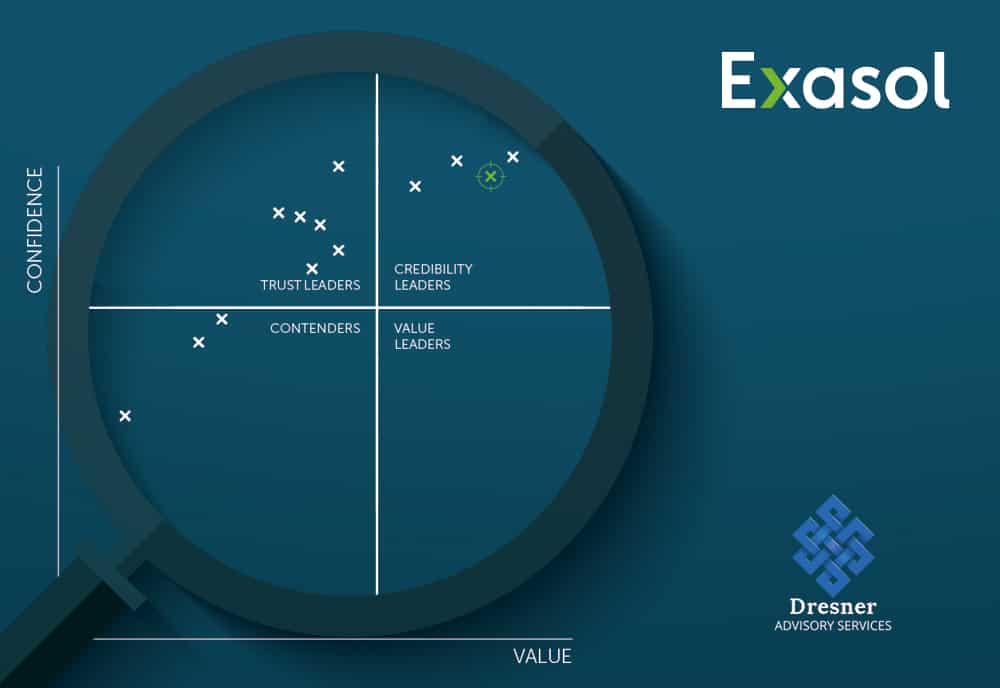Blog snapshot:
This post summarizes the key findings from the 2020 Analytical Data Infrastructure (ADI) Market Study from Dresner Advisory Services. It will cover:
- ADI use case perceptions, intentions, and the realities associated with ADI platform choices
- How Exasol ranks in the study
To data science and beyond
Today many more data-driven organizations are moving beyond conventional BI use cases for querying and reporting on business performance data. Instead the need to derive a deeper level of insight means sophisticated data practices for Loading...advanced analytics and Loading...data science are now an important consideration. This growing and diverse range of use cases also needs to be supported from a single ADI platform.
These are just some of the highlights from the recently released 2020 Analytical Data Infrastructure Market Study from Dresner Advisory Services, an industry analyst firm.
A leader in ADI
Dresner’s ADI study – which is in its fourth year –also rates vendors using 33 different criteria covering everything from the sales experience, value for price paid and integrity of the vendor.
The study is driven by the voice of the customer and that’s why we are delighted to announce that Exasol has been named a customer experience and vendor credibility leader in Dresner’s latest study and even better, we’ve received a perfect recommend score for the third year running. Which means 100% of customers would recommend us.
Uncovering the priorities and realities of ADI investment
Dresner’s study also throws more light on the priorities and preferences of organizations for ADI platforms. Drilling into the detail of the study has uncovered some interesting data points about the state of play of the market, for example:
Evolving toward advanced analytics
It was interesting to note that data science is a high priority for over 50 % respondents of the ADI survey, up from 43% last year.
Analytical Data Infrastructures have been a key component of the Business Intelligence (BI) landscape for what seems like forever. And while they offer mission critical access to trusted sources of business data, it’s becoming clear the ground is shifting – buyers are demanding far more from their ADI.
Advanced analytics and data science promises to help organizations achieve new levels of foresight and performance. It is becoming central to solving complex, data-rich business problems such as customer behavioral analysis and customer churn prediction.
It’s therefore little surprise that the study also found marketing and sales (customer facing functions) rate data science as their highest ADI use case priority compared with other business functions.
We believe this move is also prompted by growing analytics maturity, wider datasets and easy access to higher-performance compute platforms, such as in-memory databases.
When looking at ADI features important to data science, it’s worth noting that user-defined functions and Loading...machine learning rated highly, an increase over 2019.
Similarly, a higher-than-average priority is given to support for programming languages and open source licensing models for data science. This we believe reflects a need to utilize popular, lower cost and dynamic languages such as Loading...Python and R to help accelerate access to advanced analytics.
The journey to the cloud via hybrid
Respondents view cloud deployment as their highest priority in this year’s survey. However, it is interesting that while most business functions prefer this model, IT organizations don’t. This is most likely driven by both political as well as use case demands.
The reality is that some ADI use cases are predisposed for as-a-cloud services whereas others are better suited to on-premises deployment. As a result, multiple buying centres end up creating a hybrid deployment model for ADI platforms, which, according to the survey is a preference that increases with company size.
It is our belief that many organizations have a hybrid model by default especially as they start or continue their transition toward the cloud. This perhaps explains why cross data center integration and management for cloud and on-premises is becoming a growing ADI priority for respondents.
It’s all about performance
When looking at the top-level selection priorities of the ADI platform, performance once again is rated top for the fourth year running. Around 80% of respondents viewed it as critical or very important.
It’s not hard to see why when looking at the workload and data management priorities.
With the top response, more than 80% of those surveyed have analytics workloads and workflows based on transactional data sources, something that has remained consistent for the last 4 years.
SQL data capabilities are, by far, the highest priority for an ADI platform and 50% of respondents indicate Loading...in-memory is a priority, which is up from 2019.
Overall we believe this reflects a strong preference for a data platform that is future proof; one that can manage existing and more conventional workloads but support the range of innovation and diversity of use cases needed, all the while managing this at scale. The bottom line is, when an ADI platform is put to the test, performance really does matter.
